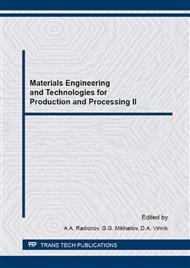[1]
G. Totten, M. Howes, T. Inoue, Handbook of Residual Stress and Deformation of Steel, ASM International, Materials Park, Ohio, (2002).
Google Scholar
[2]
F. Rustichelli, J.J. Skrzypek, Innovative technological materials, Structural properties by neutron scattering, Synchrotron radiation and modeling, Springer, London-New York, (2010).
DOI: 10.1007/978-3-642-12059-6
Google Scholar
[3]
V. Hauk, Structural and residual stress analysis by nondestructive methods: evaluation, application, assessment, Elsevier Science B.V., Amsterdam, (1997).
Google Scholar
[4]
L. Suominen, M. Khurshid, J. Parantainen, Residual stresses in welded components following post-weld treatment methods, in: Procedia Engineering 5th Fatigue Design Conference, Volume 66, 2013, pp.181-191.
DOI: 10.1016/j.proeng.2013.12.073
Google Scholar
[5]
N.A. Yablokova, V.V. Trofimov, XRA Study of the Stress-Strain State of the Compressor Blades, Zavodskaja laboratorija: Diagnostika materialov. 1 (2013) 36-44. URL: http: /www. zldm. ru/content/article. php?ID=1511.
Google Scholar
[6]
E.P. Nikolaeva, E.V. Gridasova, V.V. Gerasimov, The application of x-ray diffraction and Barkhausen Noise for studying of Shot Peened constructional steel 30HGSA, Proceedings of the Samara Scientific Center of the Russian Academy of Sciences. 2 (2015).
Google Scholar
[7]
E.P. Nikolaeva, Burkhouse Noise method application for the control of detail surface plastic deformation hardening, Proceedings of the Samara Scientific Center of the Russian Academy of Sciences. 6 (2013) 428-431.
Google Scholar
[8]
E.P. Nikolaeva, A. Yu. Nikolaev, Application of magnetic methods for quality control of products made of tool steel, The life cycle of construction materials, in: Proceeding of 2th Mezdunarodnoi Vserosiiskoi nauchno-tehnicheskoi konferentsii, Irkutsk. (2012).
Google Scholar
[9]
A.A. Veprev, A.V. Sergunov, I.M. Golovnykh, A.E. Pashkov, R.H. Akhatov, A.K. Shmakov, A.V. Savilov, Experience and perspectives of higher education institutions science participation in creation of advanced technologies in aircraft building on the basis of Irkut corporation, Oboronnui complex - nauchno-tehnicheskomu progressu Rossii. 4 (2012).
Google Scholar
[10]
A.E. Pashkov, Technological complex for long-length panels and skins forming on the basis of domestic equipment, Proceedings of the Samara Scientific Center of the Russian Academy of Sciences. 1 (2014) 1528-1535.
Google Scholar
[11]
A.E. Pashkov, On application features of domestic and foreign technology of aircraft skin and panel forming, VESTNIK Publishers of Irkutsk National Research Technical University. 5 (2015) 17-21.
Google Scholar
[12]
A.E. Pashkov, The automated technology of combined forming the aircraft panels, Proceedings of the Samara Scientific Center of the Russian Academy of Sciences. 6 (2013) 453-457.
Google Scholar
[13]
A.V. Savilov, D.S. Nikulin, E.P. Nikolaeva, A.E. Rodygina, Current state of manufacturing high performance cutting tools from powdered metal High-speed steels and hard alloys, VESTNIK Publishers of Irkutsk National Research Technical University. 6 (2013).
Google Scholar
[14]
A.E. Balanovsky, Plasma surface metal hardening, IGTU, Irkutsk, (2006).
Google Scholar
[15]
Information on http: /www. istu. edu/structure/54/3218.
Google Scholar
[16]
Information on http/www. azbukametalla. ru/spravochnik/293-modul-normalnoj-uprugosti. html.
Google Scholar
[17]
GOST 535-2005, Rolled bar stock and structural section of carbon steel of ordinary quality, General specifications.
Google Scholar
[18]
V.V. Huy, Plasma carburizing of carbon steel in solid phase using pastes, Bulletin of Science and Education of the North-West Russia. 1 (2015). URL: http: /vestnik-nauki. ru.
Google Scholar
[19]
V.V. Trofimov, A.G. Akulichev, Non-destructive testing of steel hardness Items for broadening of the diffraction lines. URL: http: /www. mmf. spbstu. ru/konf_2011/17. pd.
Google Scholar


